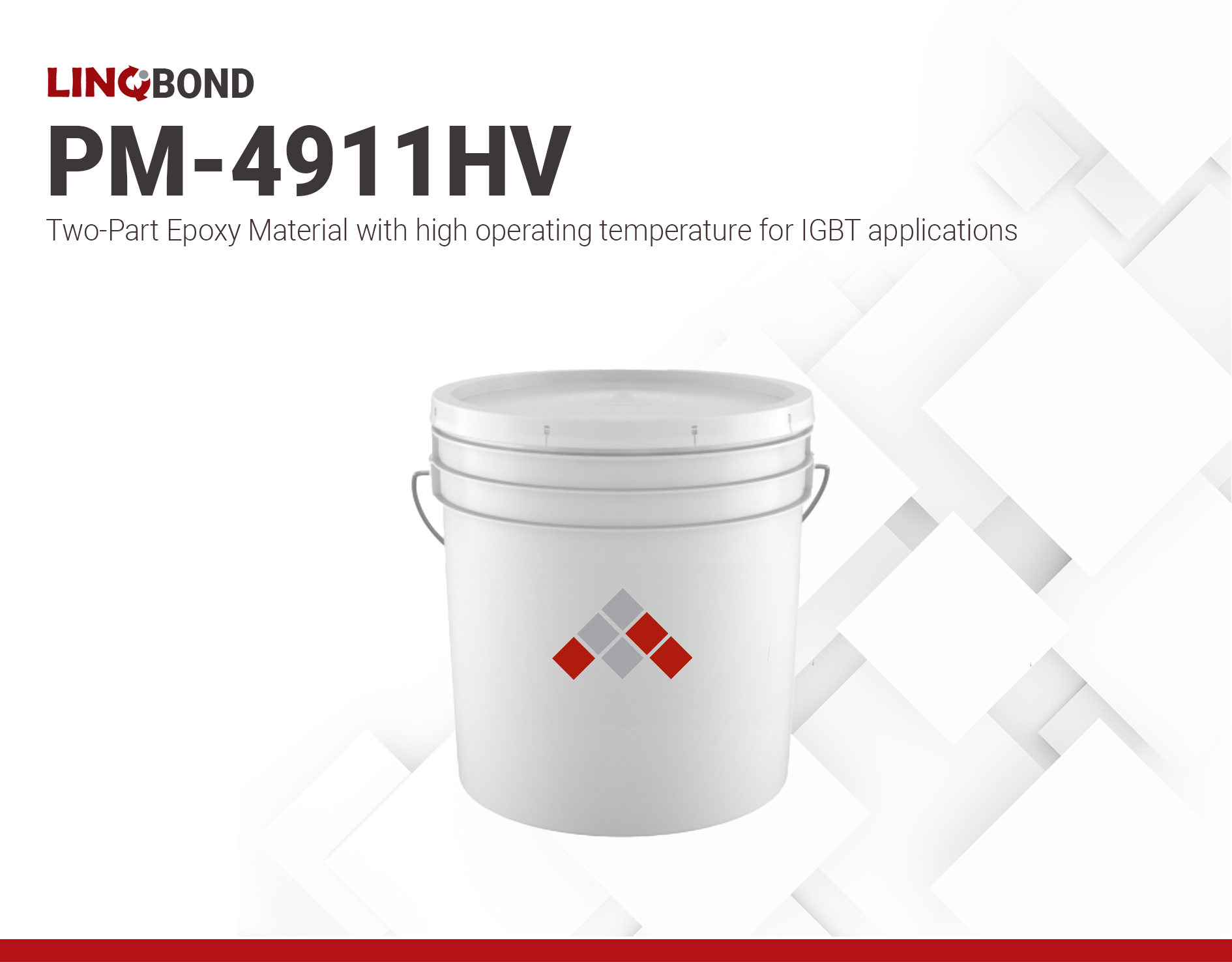LINQBOND PM-4911HV | Two part silicone potting material
- Low stress silicone potting gel
- Low viscosity, good leveling, and bubble-free curing
- Excellent long term temperature resistance
Product Description
LINQBOND PM-4911HV is a two-component, low-stress transparent packaging adhesive. When the two components are mixed in a 1:1 ratio (by volume), they cure into a soft silicone gel. This gel offers buffering, shock absorption, insulation, waterproofing, and moisture-proof functions for electronic components. With a very low modulus, it generates minimal internal stress and exhibits robust resistance to cold and heat shock.
LINQBOND PM-4911HV also exhibits excellent adhesion on various surfaces, making it suitable for insulating a wide array of electronic components. PM-4911HV is a version of PM-4911, with a higher operating temperature range and viscosity. PM-4911HV passed CTI tests with PLC 0 rating, relative thermal index (RTI) value of 150°C, and a UL 94 HB flammability rating.
Applications
- IGBT modules
- Suitable for all kinds of electronic components with insulation protection and isolation of external pollutants;
- Protection of precision components and electronic equipment
- Various display potting protection
Cure schedule
- Room temperature curing: 12 h
- Heat curing at 100 °C for 30–60 mins
Technical Specifications
| General Properties | |||||
| Mix Ratio Mix Ratio The amount of a constituent divided by the total amount of all other constituents in a mixture | 1:1 | ||||
| Pot Life Pot Life Pot life is the amount of time it takes for the viscosity of a material to double (or quadruple for lower viscosity materials) in room temperature after a material is mixed. It is closely related to work life but it is not application dependent, less precise and more of a general indication of how fast a system is going to cure. | 0.5 hours | ||||
| |||||
| Physical Properties | |||||
| Viscosity Viscosity Viscosity is a measurement of a fluid’s resistance to flow. Viscosity is commonly measured in centiPoise (cP). One cP is defined as the viscosity of water and all other viscosities are derived from this base. MPa is another common unit with a 1:1 conversion to cP. A product like honey would have a much higher viscosity -around 10,000 cPs- compared to water. As a result, honey would flow much slower out of a tipped glass than water would. The viscosity of a material can be decreased with an increase in temperature in order to better suit an application | 900-1100 mPa.s | ||||
| Electrical Properties | |||||
| Breakdown Voltage Breakdown Voltage Breakdown voltage is the minimum voltage necessary to force an insulator to conduct some amount of electricity. It is the point at which a material ceases to be an insulator and becomes a resistor that conducts electricity at some proportion of the total current. After dielectric breakdown, the material may or may not behave as an insulator any more because of the molecular structure alteration. The current flow tend to create a localised puncture that totally alters the dielectric properties of the material. This electrical property is thickness dependent and is the maximum amount of voltage that a dielectric material can withstand before breaking down. The breakdown voltage is calculated by multiplying the dielectric strength of the material times the thickness of the film. | 18000 V | ||||
| Volume Resistivity Volume Resistivity Volume resistivity, also called volume resistance, bulk resistance or bulk resistivity is a thickness dependent measurement of the resistivity of a material perpendicular to the plane of the surface. | 1.0x1015 Ohms⋅cm | ||||
| Thermal Properties | |||||
| Operating Temperature | 250 °C | ||||
| Thermal Conductivity Thermal Conductivity Thermal conductivity describes the ability of a material to conduct heat. It is required by power packages in order to dissipate heat and maintain stable electrical performance. Thermal conductivity units are [W/(m K)] in the SI system and [Btu/(hr ft °F)] in the Imperial system. | 0.4 W/m.K | ||||
| UL 94 Rating UL 94 Rating Flammability rating classification. It determines how fast a material burns or extinguishes once it is ignited. HB: slow burning on a horizontal specimen; burning rate less than 76 mm/min for thickness less than 3 mm or burning stops before 100 mm V-2: burning stops within 30 seconds on a vertical specimen; drips of flaming particles are allowed. V-1: burning stops within 30 seconds on a vertical specimen; drips of particles allowed as long as they are not inflamed. V-0: burning stops within 10 seconds on a vertical specimen; drips of particles allowed as long as they are not inflamed. 5VB: burning stops within 60 seconds on a vertical specimen; no drips allowed; plaque specimens may develop a hole. 5VA: burning stops within 60 seconds on a vertical specimen; no drips allowed; plaque specimens may not develop a hole | HB | ||||
Additional Information
Premixed Properties
Property | Part A | Part B |
Appearance | Transparent | Transparent |
Density [g/cm3] | 0.96–0.98 | 0.96–0.98 |
Viscosity [cP] | 900-1100 | 900-1100 |
Precautions before Use
- Avoid contact with condensed silicone rubber, its gas, nitrogen, sulfur, phosphorus, and other chemicals, including heavy metals, as they may inhibit curing of the product.
- Maintain a clean and ventilated workplace, using extraction trunks when necessary.
- Wear appropriate protective equipment and minimize direct contact with the human body. Refer to the Material Safety Data Sheet (SDS) before use.
Storage and Handling
Store in a well-ventilated, dry area below 25 °C, away from fire and heat sources. Avoid outdoor storage. For extended shelf life, consider cold storage. Shelf life is 12 months under recommended conditions.



